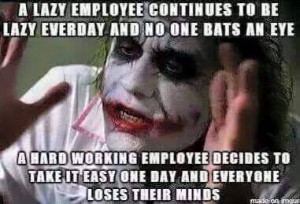No, The Customer Is Not Always Right
Submitted by Rachel Morales on The I Hate Working In Retail Facebook Page
How many times have you had to grit your teeth, take a deep breath and silently repeat to yourself, “The customer is always right”? This is a motto that’s drilled into every young retail or hospitality worker, and has somehow made its way into the psyches of established business owners.
The problem is, the customer isn’t always right, and always thinking otherwise can result in serious disservice to you, your employees, and your customers. Here’s why.
1. Unreasonable customers eat away at your finite resources.
You only have limited resources available to you; don’t allocate a disproportionate amount of them to customers who repeatedly cause problems. You only have so much time, money and energy to dedicate to customer service, or to your business, and an unreasonable customer or client can quickly eat away at the majority of it.
If you’ve tried your best to address a complaint and the customer still isn’t happy, it’s time to move on from that customer. Use your limited resources to address the concerns of customers who are willing to engage in reasonable dialogue with you. When you focus on meeting the needs of your reasonable customers, you build loyal brand ambassadors…and I’d rather have a bunch of these than throw all my resources at customers who are impossible to please.
In his book Customer Centricity, Peter Fader encourages business owners to focus on the customers who matter most: “Not all customers deserve your company’s best efforts. And despite what the old adage says, the customer is most definitely not always right. Because in the world of customer centricity, there are good customers…and then there is everybody else.”
In Tim Ferriss’ wildly popular and successful book, The 4 Hour Workweek, Ferriss recounts a personal story early in the book which details how he nearly hit his mental breaking point because he was trying to please every customer. He soon discovered that a few customers were taking the majority of his bandwidth and causing the majority of his stress, though they contributed only a relatively small percentage of the company’s total revenue. His solution? He gave the clients an ultimatum: if they couldn’t do business his way, he didn’t want to do business with them at all. The result? Some of the clients changed to accommodate Ferriss’ requests. Others refused to change, so he fired them. Ferriss’ mental overhead drastically decreased, and his business soared as he only accepted clients that fit his ideal customer model from that point onward.
The lesson here is to allocate the majority of your valuable resources to your good customers, and stop trying to please everyone all the time.
2. This mindset positions employees against customers and management.
If you’re lucky enough to have found employees who you trust and respect, don’t risk losing them by siding with the customer by default. When you tell your employees “the customer is always right”, you immediately position them against the customer – and the customer always wins.
If you want to keep your employees happy and effective, back them up. Prove to them that you respect their judgment and opinions, and when faced with siding with your employee or an unreasonable customer, always choose your employee.
According to Alexander Kjerulf, author of Happy Hour is 9 to 5, happy employees lead to the best possible customer service: “Believing the customer is always right is a subconscious way of favouring the customer over the employee which can lead to resentment among employees. When managers put the employees first, the employees will then put the customers first. Put employees first and they will be happy at work”.
Putting employees first may also lead to an increase in perceived control among employees. And according to Ravi Tangri, author of Stress Costs, Stress Cures: How to Recover Productivity Lost to Stress, this increased control can have very concrete benefits: “Workers with high levels of perceived control are not as likely to report high levels of conflict or interference between work and their family lives. The more control an employee feels over his own health and over things that happen to him at work, the less likely he is to report absences totaling six days or more in the previous year.”
3. Money isn’t everything. Not even close.
We’ve all had customers or clients who have unrealistic expectations of what we can or should do to keep them happy. They demand – whether explicitly or implicitly – more of our time, energy and resources than our other clients.
It was recently reported that Chicago-based ad agency Cramer-Krasselt fired big-name client Panera Breads because of a poor working relationship. In a leaked internal memo, the agency claimed that the troubled working relationship just wasn’t worth it. In the memo, Peter Krivkovich, chairman-CEO of Cramer-Krasselt wrote: “There comes a time when no matter what the acclaim for the work, no matter what that visibility, no matter how good of a relationship we have with the marketing department…in the end, no amount of money makes it worthwhile.”
Don’t be afraid to cut ties with customers or clients who repeatedly make unrealistic demands or who consistently cause stress or friction. Rather than continually sacrificing your time, dignity and emotional health, focus your efforts on actively pursuing new customers or clients who respect your time and boundaries.
Final Thoughts
Just because your customers aren’t always right, doesn’t mean you can’t learn from them. I love the Bill Gates quote: “Your most unhappy customers are your greatest source of learning.” If you have a customer or client who is seemingly impossible to please, learn from them; this doesn’t mean you need to keep them as a customer, but ask yourself what you can do differently in the future to avoid a similar problem.
I would also like to note that I’m not suggesting we simply give up on resolving conflict with customers. I’m simply saying this: Look at the bigger picture when dealing with consistently unreasonable customers or clients. Look at what’s really important, and ask yourself if repeatedly attempting to please an unpleaseable customer is really the best business decision.
What do you think: Is the customer always right? If not, how do you know when ‘enough is enough’? Share below!
Sourced from forbes.com
























Recent Comments